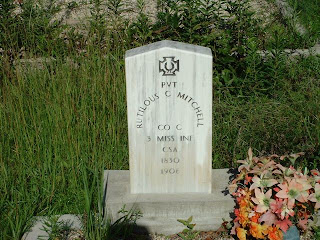Jerry Stough
The nucleus of the Third Regiment was the Shieldsboro Rifles and the Gainesville Volunteers. These two units reported in camp Clark at Shieldsboro in August, 1861. The Third was mustered into Confederate service in October, 1861 and sent to reinforce General Leonidas Polk in Columbus, KY in November of 1861. Governor Pettus and others complained so strongly, that in January 1862 the Third was returned to the Coast. The coast defenses at this time consisted of The Third Regiment, the Seventh Regiment, two batteries, and Captain Norman’s Cavalry.
In late February, the Seventh Regiment was sent to Jackson, Tennessee to reinforce General P. T. G. Beauregard’s Army of Mississippi. A grave mistake was made in coastal defense when the Third was split into two camps. One camp was at Pass Christian with three companies and the other camp was at Handsboro with seven companies. When General Butler landed about 1200 troops at Pass Christian on April 4, 1862, the three companies were easily over powered and retreated to Gainesville. The seven companies at Handsboro also pulled back and marched overland to Gainesville. I have been unable to determine if Company G was in camp at Handsboro or Pass Christian.
Following the retreat to Gainesville, the Third returned to Pass Christian, then to New Orleans and by May 1862 were in Camp Moore in Tangipahoa, LA. On May 29, 1862 the regiment was ordered to Vicksburg to reinforce Gen. M. L. Smith. They were on picket duty during Admiral Farragut’s bombardment in May, June and July 1862. They served in fortifying Sugar Loaf Hill and picket duty along the river front until ordered to Snyder’s Mill in December, 1862.
The regiment operated on the Rolling Fork and Sunflower against Federal expeditions in March and on March 28 the Third went to Fort Pemberton, at the junction of the Tallahatchie and Yazoo. The Federals were attempting to open a pathway through the Yazoo Pass into the Tallahatchie and then the Yazoo in an attempt to reach Vicksburg from the Yazoo River. They were stopped at Fort Pemberton. For more information on this expedition see Michael B. Ballard’s Civil War In Mississippi.
At the Battle of Baker’s Creek (also known as Champion Hill) the Third did a lot of marching in an attempt to get in position until they were ordered in the afternoon to cover the retreat to Edwards. In their attempt to find a crossing of Baker Creek the regiment was again divided. Some of the men retreated to the fortifications of Vicksburg (about 72 men) and the larger portion of the regiment not finding a guide to the crossing turned back toward Crystal Springs and Jackson. This group joined Joseph E. Johnston’s troops who were in Jackson rather than Vicksburg. As part of General Johnston’s troops they confronted General Sherman’s Meridian Campaign.
Transferring in the spring of 1864 to Alabama, the Third took part in the Atlanta Campaign against William T. Sherman’s army. They were engaged at Resaca, New Hope Church, Kenesaw Mountain, and Peachtree Creek. Following the fall of Atlanta, Hood’s army pulled back to Dalton, GA and to Gadsden, Alabama. In November, 1864 the Third marched to Columbia, on to Spring Hill and then to Franklin, Tennessee where the Confederates were soundly defeated. Defeated at Nashville, the entire army pulled back to Brentwood, then crossed the Duck River and the Tennessee River reaching Tupelo January 8, 1865.
Ordered to the Carolinas to reinforce General Johnston, they participated in the battles of Kinston and Bentonville in March. Hostilities were suspended April 18, and the army was surrendered, near Durham Station, April 26.



